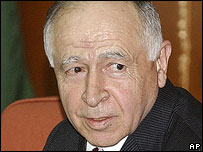
Weaknesses in State Institutions Ignites Ethnic Unrest in Northern Dagestan
Publication: Eurasia Daily Monitor Volume: 6 Issue: 149
By:

On July 27 a group of ethnic Kumyks, one of the major ethnic groups in Dagestan, blocked the federal highway "Kavkaz" in northern Dagestan. According to various estimates, three to four hundred people took part in the protests. Heavy trucks and other vehicles were used to obstruct the highway traffic. The protestors demanded a just investigation into a criminal case that dated back to April. The standoff risked an armed resolution, when the authorities intervened and managed to break up the gathering (Caucasian Knot, July 27).
The Kumyks representatives stated that while their people were held in detention, on the other side of the conflict, an ethnic Avar was unjustly released. In an ethnicity based power sharing scheme an Avar, Saigid-Pasha Umakhanov has occupied the post of mayor in Khasavyurt city in northern Dagestan, whereas the Khasvyurt district is headed by an ethnic Kumyk, Alimsoltan Alkhamatov.
On April 28 unknown criminals killed the nephew of the Khasavyurt city’s mayor in an ambush, whose father (the brother of the mayor), was also the deputy of the Dagestani parliament (Regnum, April 28). When it was revealed that the suspects were Kumyks, it resulted in an escalation of interethnic tension in the area, forcing the Dagestani authorities to interfere. According to the 2002 census, the Kumyks are the third largest ethnicity after the Avars and the Dargins. Their absolute numbers in Dagestan are 365,000 or 14 percent of the total population of Dagestan. The Avars are more than twice more numerous, 760,000 and 30 percent respectively (www.worldgeo.ru/russia/lists/?id=33&code=5).
The situation was further complicated by the fact that the killers had originally meant to kill another relative of the Khasavyurt’s mayor Magomed Umarov. One policeman and a participant in the gang alleged that Magomed Umarov had beaten him up several times and that his boss had not reacted to his complaints, as Umarov was believed to have powerful connections. According to the suspects, this led them to take justice into their own hands. In order to resolve the dispute, which risked a major destabilization of the region, the authorities brokered a deal allowing each side to be tried "according to the law" (Chernovik Weekly, July 31). The people of northern Dagestan have a reputation for being more resolute, than their compatriots elsewhere within the republic, so the authorities’ fears might have been well-founded.
The President of Dagestan Mukhu Aliev, who is an ethnic Avar himself, the largest ethnicity in Dagestan and one of the largest in the North Caucasus, accused the regional authorities, and evidently the Kumyk side of tacit support for the protestors. Aliev also admitted that mass protests in Dagestan had become increasingly involved in blocking the roads (www.riadagestan.ru, July 30). The latest flare up of tension was caused by Umarov’s release, while on the Kumyk side of the issue six people were remanded in police custody. The protestors demanded that their people should also to be released, once the Avar side had been freed (Chernovik Weekly, July 31).
Khasavyurt is the second largest city in Dagestan after its capital Makhachkala with an estimated population of 135,000 people. Its economic importance, based largely on its wholesale markets is also complemented by its political significance. The mayor of Khasavyurt, Saigidpasha Umakhanov was able to challenge the previous head of Dagestan and an ethnic Dargin, Magomedali Magomedov, forming the so-called Northern Alliance. Since Mukhu Aliev came to power in 2006, Umakhanov has maintained a low political profile. Moreover, its close proximity to neighboring Chechnya adds an additional political importance to the city.
The recent incident highlights the political weaknesses of Dagestan: the police are unable to challenge the powerful political clans and the government does not have a monopoly on the use of force. The warring political clans revert to using mass protests in order to achieve their goals, as there are few alternative ways to peacefully resolve existing problems. Even though the authorities managed to unblock the highway this time, the protestors promised to return if their ethnic brethren detainees were not released (Caucasian Knot, July 27). This demonstrates the level of distrust for government institutions and their promises in Dagestan, as the latter do not deliver on vital services, such as providing justice.
The essentially interethnic strife also undermines the much-propagated idea that such issues are dying out. This view is held not only by many Moscow-based analysts, but also surprisingly by the insurgents’ Islamic ideologues in the Northern Caucasus. They both ignore many indications that ethnic issues and nationalism have not disappeared in the region, but rather were temporarily subdued by other more pressing issues.
The events in Khasavyurt also mark a positive side to Dagestani politics. Due to the multiple ethnicities and the culture of power sharing among them, authoritarian rule in the republic can almost certainly be excluded, unlike in some of the other North Caucasus republics or even in Russia as a whole. This does not put Dagestan in the ranks of exemplary democracies, but it shows that there is potential for democratic evolution in the republic under the right conditions. Meanwhile, there is still a long way for the republic to go to transform its ethnicity based power sharing political system into a more modern political system.




